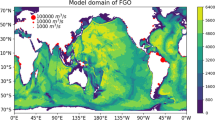Abstract
Analysis is made of wind and wave data, which were obtained during the passage of Typhoon 8013 at an Ocean Data Buoy Station south of Honshu operated by the Japan Meteorological Agency, in order to investigate the wave dependence of sea-surface roughness parameter in the situation where wind waves are dominant with less significant swells. The data fit better the wave-dependent expression of the wind stress,z 0 σ p/u*=γ, than to Charnock's formula,gz 0/u*2=β, wherez 0 is the roughness length,σ p the angular frequency of the spectral peak of wind waves,u* the friction velocity of air,g the acceleration of gravity,γ andβ are non-dimensional constants. The results are very similar to those of our previous study using data from an oil producing platform in the Bass Strait, Australia, although the type of observation system and the synoptic situation of the winds and wind waves were totally different.
Similar content being viewed by others
References
Charnock, H. (1955): Wind stress on a water surface. Quart. J. Roy. Meteorol. Soc.,81, 639–640.
Donelan, M.A. (1979): On the fraction of wind momentum retained by waves. p. 141–159.In: Marine Forecasting, ed. J.C.J. Nihoul, Elsevier, Amsterdam.
Hamada, T. (1963): An experimental study of development of wind waves. Rep. Port and Harbour Tech. Res. Inst., No. 2, 1–41.
Hatori, M. (1983): An examination of the sea waves observed by JMA Buoy No. 6. J. Meteorol. Res.,35, 119–126 (in Japanese).
Horikawa, K. (1973): Coastal Engineering. Tokyo Univ. Press, Tokyo, 317 pp. (in Japanese).
Hsu, C., H. Wu, E. Hsu and R.L. Smith (1982): Momentum and energy transfer in wind generated waves. J. Phys. Oceanogr.,12, 929–951.
Jones, I.S.F. and Y. Toba (1985): Wave data from three Bass Strait Storms. Marine Studies Centre Tech. Rep., The Univ. of Sydney,2/85, 30 pp.
Kawai, S., K. Okada and Y. Toba (1977): Support of the 3/2-power law and thegu*σ −4-spectral form for growing wind waves with field observational data. J. Oceanogr. Soc. Japan,33, 137–150.
Kenney, B.C. (1982): Beware of spurious self-correlations! Water Resources Res.,18, 1041–1048.
Kunishi, H. (1963): An experimental study on the generation and growth of wind waves. Disaster Prevention Res. Inst., Kyoto Univ., Bull., No. 61, 41 pp.
Kunishi, H. and N. Imasato (1966): On the growth of wind waves in high-speed wind flume. Annuals, Disast. Prev. Res. Inst., Kyoto Univ.,9, 667–676.
Masuda, A. and T. Kusaba (1987): On the equilibrium of winds and wind-waves in relation to surface drag. J. Oceanogr. Soc. Japan,43, 28–36.
Mitsuyasu, H. (1968): On the growth of the spectrum of wind-generated waves (I). Rep. Res. Inst. Appl. Mech., Kyushu Univ.,55, 459–482.
Merzi, N. and W.H. Graf (1985): Evaluation of the drag coefficient considering the effects of mobility of the roughness elements. Annales Geophysicae,3, 473–478.
Toba, Y. (1961): Drop production by bursting of air bubbles on the sea surface (III). Study by use of a wind flume. Memoirs of the College of Sci., Univ. of Kyoto, Ser. A,29, 313–344.
Toba, Y. (1972): Local balance in the air-sea boundary processes. I. On the growth process of wind waves. J. Oceanogr. Soc. Japan,28, 109–120.
Toba, Y. (1973): Local balance in the air-sea airboundary processes. III. On the spectrum of wind waves. J. Oceanogr. Soc. Japan,29, 209–220.
Toba, Y. (1979): Study on wind waves as a strongly nonlinear phenomenon. Twelfth Symp. on Naval Hydrodyn., Nat. Acad. of Sci., Wash., D.C., 529–540.
Toba, Y. and M. Koga (1986): A parameter describing overall conditions of wave breaking, whitecapping, sea-spray production and wind stress. p. 37–47.In: Oceanic Whitecaps, eds. E.C. Monahan and G. MacNiocaill, D. Reidel.
Toba, Y. and N. Ebuchi (1990): Multiple regimes in wave dependent wind stress—A working hypothesis—. Atmosphere-Ocean, R.W. Stewart Special Issue (submitted).
Toba, Y., S. Kawai, K. Okada and N. Iida (1985): The TOHOKU-II Wave Model. p. 227–232.In: The Ocean Surface, eds. Y. Toba and H. Mitsuyasu, D. Reidel.
Toba, Y., N. Iida, H. Kawamura, N. Ebuchi and I.S.F. Jones (1990): Wave dependence of sea-surface wind stress. J. Phys. Oceanogr.,20, 705–721.
Uji, T. (1984): A coupled discrete wave model MRI-II. J. Oceanogr. Soc. Japan,40, 303–313.
Wu, J. (1980): Wind-stress coefficients over sea surface near neutral conditions—A revisit. J. Phys. Oceanogr.,10, 727–740.
Wu, J. (1988): On nondimensional correlation between roughnes length and wind-friction velocity. J. Oceanogr. Soc. Japan,44, 254–260.
Author information
Authors and Affiliations
Rights and permissions
About this article
Cite this article
Ebuchi, N., Toba, Y. & Kawamura, H. On the wave dependence of sea-surface wind stress. Journal of the Oceanographical Society of Japan 46, 177–183 (1990). https://doi.org/10.1007/BF02125578
Received:
Revised:
Accepted:
Issue Date:
DOI: https://doi.org/10.1007/BF02125578




